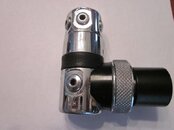You're right about the numbers, it's Tribolube 66 and 71. But they're both $210/lb from Aerospace Lubricants. Yes, I'll fill with the thicker (66, I think).
Anyone else want to weigh in on this "compressibility of rubber" thing? I think this is a legitimate concern, hence my thought about the pinholes.
I don't know what the instructions were for the old hard SPEC boot, but I figured the water leaked in around the edges when the boot was rotated to cover the ambient holes. Piston movement, even with a perfectly filled chamber, is still going to result in a little to-and-fro of goop right at the ambient holes.
With an inner tube, I am concerned that the soft rubber would make a semi-perfect seal without a pinhole, and therefore the elasticity of the rubber would decrease the transmission of ambient pressure into the environmental chamber by whatever amount of resistance it created as the rubber bulged into the hole. Therefore, the contribution to the piston would be ambient pressure minus all the little resistances imposed by the inner tube. I figure that's why the SPEC boot was hard and a little loose. It ensured water passage around the back, but still created a little barrier to decrease the mess.
I'm still in favor of pinholes, but I think I should remove the boot after every dive to allow any water to trickle out. I never saw the SPEC boot instructions, but I'll bet they said to rotate the boot so the holes lined up with the ambient chamber holes after every dive.
After I create this thing, I'll put it into my pressure chamber with some food coloring in the wet basket and run it down to 150 feet. We'll see how much water I can find inside the boot after. I'll try to post pictures.






